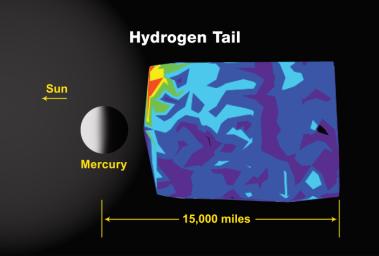
|
Mercury’s Hydrogen Tail
- Click the image above for a larger view
- Full-Res JPEG (3000 x 2025) (200.0 kB)
- Full-Res TIFF (3000 x 2025) (18.2 MB)
Caption:
This plot shows Lyman-alpha emission at 121.6 nm associated with neutral hydrogen in the near vicinity of Mercury. This is the first detection of hydrogen tail emission at Mercury and the first time that neutral hydrogen and sodium atoms have been observed in the tail simultaneously. This emission is about 100 times less intense than the sodium emission. As with the sodium emission, discovering the true spatial distribution requires more analysis. The similar asymmetries in hydrogen, derived from the solar wind, and the much heavier sodium nonetheless suggest that solar-wind interactions with Mercury's magnetosphere have played a strong role in supplying tail material at the time of MESSENGER's flyby.
Observing the Lyman alpha emission line, deep in the ultraviolet, is possible only from space. Such hydrogen emissions were also observed by Mariner 10 but only on the subsolar limb.
Calcium was detected in the near-Mercury exosphere by MESSENGER and has also been observed telescopically from Earth. Other species are expected to be seen in Mercury's exosphere as well, but the orbital phase of the mission offers better opportunities to observe them.
Background Info:
These images are from MESSENGER, a NASA Discovery mission to conduct the first orbital study of the innermost planet, Mercury. For information regarding the use of images, see the MESSENGER image use policy .
Cataloging Keywords:
| Name | Value | Additional Values |
|---|---|---|
| Target | Mercury | |
| System | ||
| Target Type | Planet | |
| Mission | MESSENGER | Mariner |
| Instrument Host | MESSENGER | Mariner 10 |
| Host Type | Orbiter | Flyby Spacecraft |
| Instrument | Mercury Atmospheric and Surface Composition Spectrometer (MASCS) | |
| Detector | ||
| Extra Keywords | Color, Magnetosphere, Ultraviolet | |
| Acquisition Date | ||
| Release Date | 2008-01-30 | |
| Date in Caption | ||
| Image Credit | NASA/Johns Hopkins University Applied Physics Laboratory/Carnegie Institution of Washington | |
| Source | photojournal.jpl.nasa.gov/catalog/PIA10199 | |
| Identifier | PIA10199 | |
